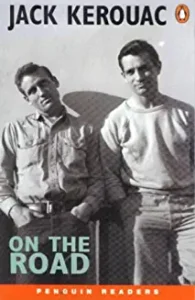On the Road by Jack Kerouac 1957
Kerouac, the son of French Canadian immigrants who grew up poor in Lowell, MA and went to Columbia on a football scholarship, wrote what many consider the classic book of the Beat Generation. Dropping out of Columbia, he began to write novels and stories at a furious pace with mixed success until he finally was able to get his road book down on paper,
Stimulated by his meeting Neal Cassady, the model for Dean Moriarty in the book, Kerouac (Sal Paradise in the book) had traveled back and forth from NYC to San Francisco a number of times and had always wanted to chronicle those journeys. He finally did so in 1951 in three weeks of marathon writing at a typewriter through which flowed twelve foot long sheets of tracing paper taped together so he would not have to interrupt the flow, what H.L. Mencken referred to as ‘typing not writing’. Kerouac continued to work on the book for four years after that marathon writing period, finally getting it published in 1957 with the help of the critic Malcolm Cowley in a form near but not identical to his original.
The book is not an easy read with 300+ closely spaced pages with few paragraph breaks. It reads as a stream of consciousness and activity, chronicling his travels back and forth across America by car, bus, hitchhiking, jumping freights, bus and walking via both the northern and the southern routes. Along the way we meet characters fashioned on Allen Ginsberg, William Burroughs, and of course Kerouac and Cassady, The book portrays the struggles of Kerouac in his late 20’s to find meaning and purpose in his life, a life filled with drinking, smoking weed, broken relationships, jazz, colorful characters, women, and endless travel in an attempt to stave off TIME.
The lack of a plot or a narrative arc helped me understand why fiction succeeds where memoir often fails. I would probably have stopped reading the book halfway through if not for my commitment to only review books I’ve completely read. The book may be the most important statement of the Beat generation’s alienation and anguish, but it felt overdone and overlong and aimless to me. His portrayals of New York and San Francisco, their jazz scenes especially his identification with “Negro” musicians, and the emptiness of the post WWII world were worth reading, but not over and over again.
Another classic finally read, but not recommended. One interesting observation that resulted from reading Kerouac and Didion in close proximity was the reliance of both on long lists of objects, activities, and observations. Didion’s adoption of that technique may be a characteristic of California’s bigger than life nature.



